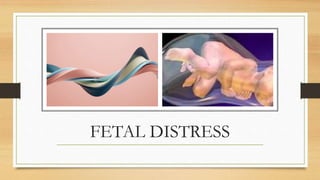FEtal distress.pptx
- 2. WHAT IS FETAL DISTRESS? • Fetal distress, also known as non-reassuring fetal status, is a condition during pregnancy or labor in which the fetus shows signs of inadequate oxygenation. • Due to its imprecision, the term "fetal distress" has fallen out of use in American obstetrics. • The term "non-reassuring fetal status" has largely replaced it. • It is characterized by changes in fetal movement, growth, heart rate, and presence of meconium stained fluid.
- 3. RISK FACTORS • Anemia, restriction of fetal growth, maternal hypertension or cardiovascular disease, low amniotic fluid or meconium in the amniotic fluid, or a post-term pregnancy. • The condition is detected most often with electronic fetal heart rate (FHR) monitoring through cardiotocography (CTG), which allows clinicians to measure changes in the fetal cardiac response to declining oxygen. Specifically, heart rate decelerations detected on CTG can represent danger to the fetus and to delivery.
- 4. Other Risk Factors • Low amniotic fluid (oligohydramnios) • If there is too little amniotic fluid around the baby in the uterus, the baby can have trouble moving around in the uterus and its growth and temperature can be impacted. Low amniotic fluid can be caused by placental issues, high gestational blood pressure, some medications, as well as problems with the fetal kidney or urinary tract.[9] • Meconium in the amniotic fluid • If a fetus has meconium in their lungs when they are born, this prevents the pressure in their lungs from falling, which normally facilitates the transition to independent breathing. Since aspiration of meconium can lead to improper oxygenation due to obstruction and carries the potential risk for inflammatory pneumonitis, this is an important diagnosis to make in the setting of newborn respiratory distress.[10] • Gestational Hypertension • If hypertension in the mother occurs after the 20th week and meets certain criteria, this is considered preeclampsia/eclampsia. The mechanism of preeclampsia/eclampsia is unknown, but consequences if left untreated can include fetal growth restriction or death, as well as pose medical risks to the mother. Signs and symptoms of preeclampsia can include swelling, protein in the urine, headaches, vomiting, and abnormal labs that assess kidney and liver function, some of which may be considered severe preeclampsia or eclampsia
- 5. Treatment • Treatment primarily consists of intrauterine resuscitation, the goal of which is to restore oxygenation of the fetus. • This can involve improving the position, hydration, and oxygenation of the mother, as well as amnioinfusion to restore sufficient amniotic fluid, delaying preterm labor contractions with tocolysis (labor supresant), and correction of fetal acid-base balance.
- 6. Signs and symptoms • Decreased movement felt by the mother • Meconium in the amniotic fluid ("meconium stained fluid") • Non-reassuring patterns seen on cardiotocography: • increased or decreased fetal heart rate (tachycardia and bradycardia), especially during and after a contraction • decreased variability in the fetal heart rate • late decelerations - Characterized by a gradual reduction in fetal heart rate (FHR) • Biochemical signs, assessed by collecting a small sample of baby's blood from a scalp prick through the open cervix in labor • fetal metabolic acidosis - high amounts of acid levels in an unborn baby’s blood due to low supply or deprived of O2
- 7. COMPLICATIONS • Complications are primarily those associated with insufficient fetal oxygenation, most notably increased mortality risk. • Fetal encephalopathy (abnormal brain function) • Seizures • cerebral palsy • neurodevelopmental delay
- 8. PREVENTION • PRENATAL CHECK UP • Monitoring of the mother and fetus prior to birth is critical to avoid complications after birth. • This is often done via electronic fetal heart rate (FHR) monitoring, which helps providers monitor the fetus' heart rate to ensure it is receiving enough oxygen, monitor the mother's contractions, and monitor the mother's blood pressure and systemic symptoms for gestational hypertension, preeclampsia, or eclampsia.



![Other Risk Factors
• Low amniotic fluid (oligohydramnios)
• If there is too little amniotic fluid around the baby in the uterus, the baby can have trouble moving around in the uterus and its growth and
temperature can be impacted. Low amniotic fluid can be caused by placental issues, high gestational blood pressure, some medications, as
well as problems with the fetal kidney or urinary tract.[9]
• Meconium in the amniotic fluid
• If a fetus has meconium in their lungs when they are born, this prevents the pressure in their lungs from falling, which normally facilitates
the transition to independent breathing. Since aspiration of meconium can lead to improper oxygenation due to obstruction and carries the
potential risk for inflammatory pneumonitis, this is an important diagnosis to make in the setting of newborn respiratory distress.[10]
• Gestational Hypertension
• If hypertension in the mother occurs after the 20th week and meets certain criteria, this is considered preeclampsia/eclampsia. The
mechanism of preeclampsia/eclampsia is unknown, but consequences if left untreated can include fetal growth restriction or death, as well
as pose medical risks to the mother. Signs and symptoms of preeclampsia can include swelling, protein in the urine, headaches, vomiting,
and abnormal labs that assess kidney and liver function, some of which may be considered severe preeclampsia or eclampsia](https://image.slidesharecdn.com/fetaldistress-230321020504-62c2a2d1/85/FEtal-distress-pptx-4-320.jpg)




